Thursday, September 28, 2006
YSLA DE BINONDO AND THE CHINESE REVOLT
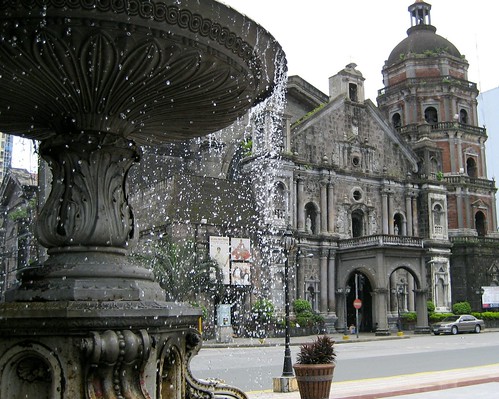
Located at Plaza Calderon de la Barca, Binondo Church, also known as Minor Basilica of Saint Lorenzo, was founded by the Dominican Friars in 1596. It has sustained considerable damage over the centuries from earthquakes and other natural disasters, as well as from fierce bombings during World War II. It wasn’t until 1972 that it was restored, but the octagonal bell tower and some foundations remain of the original 16th century structure, which is typical of colonial Spanish architecture. Today, its maintenance is largely funded by the members of the Catholic Chinese community; most reside and operate business establishments in the area.
Binondo, an hacienda once like Makati, is an island between two estuaries or esteros — Estero de la Reina and Estero de Binondo. The village of Binondo sprang in the banks of the Pasig River, and was once called Ysla de Binondo. It was already a hub of Chinese commerce even before Martin de Goiti and his men forcibly took over Manila in 1570 from its Muslim kings.
Two years before this church was built, in 1594, the Spaniards gave the land to the Catholic Chinese tax-free and Binondo was established with limited self-governing privileges. This was to encourage their loyalty to Spain while keeping them culturally at a distance. Nonetheless, just across the Pasig River, from the gated walls of Intramuros, the Spaniards aimed the range of their cannons at this Chinese enclave in case of an uprising.
The Galleon Trade ensued thereafter which sailed between Manila and Acapulco and linked the Chinese junk trading system to Mexico and to the rest of Europe. For 250 years, galleons sailed 9000 nautical miles. When the Spaniards settled in the country, more Chinese came. And as the population of the Chinese grew in Manila, the mutual feeling of fear and distrust between them and the Spaniards rose as well. Consequently, such mutual suspicions manifested persecution and harassment including large-scale massacres.
In 1581, Governor General Gonzalo Ronquillo Peñalosa's heightened fear of the Chinese led him to issue a directive to round up the scattered communities of early Chinese migrants and forced them to settle at the Settlement of San Gabriel. They were also subjected to forced labor in building the Walls of Intramuros. Travel to the island was through the Duente de Spaña Bridge built by the Spanish authorities in 1632 (where it was replaced by Jones Bridge). At that time, by law, all Chinese were forced to reside in the areas of Ysla de Binondo, San Nicolas and Sta. Cruz.
The Spaniards separated the Chinese in quarters called Parian. By 1596, led by their padrinos, most citizens of Parian, were baptized as Catholics, thus creating the Chino cristianos. By virtue of their new faith, they were granted more freedom than the unconverted Chinese and could marry the natives. In 1790, when the last Parian was destroyed, the Chinese were allowed to join the baptized Chinese in Binondo and Santa Cruz. Sangley, the term used by the Spaniards for the Chinese, comes from the word siong-tay, literally "often comes" in Hokkien. The Sangleys came as merchants, laborers, and artisans. Due to massacres or fires, the Spaniards changed the location of the Parian nine times.
The first major Chinese revolt against the Spaniards occurred on October 25, 1593. It was led by Pua Ho Go (P’an Ho Wu in Mandarin) who, along with 250 Chinese, was enlisted compulsorily as boat rower for a military expedition to Moluc¬ca Islands in Indonesia, led by Governor-General Gomez Perez Dasmariñas.
It was a series of failed expeditions — in 1582, he had to go home after two-thirds of the expedition were downed by epidemic; 1584, no luck, either. Finally, in 1593, Dasmariñas had with him in his galley 80 Spaniards and 250 Chinese galley slaves. The vessel was put into port near Batangas for shelter due to contrary winds. In the silence of the night, when the Spaniards were asleep, the galley slaves led by Pua Ho Go killed them all, except for a Franciscan friar and secretary. Dasmariñas was the only Spanish governor-general and the highest ranking Spanish official in the Philippines ever killed by the insurgents.
On October 3, 1603, the Spanish colonial regime carried out the first massacre of the Chinese in the Philippines, in which more than 23,000 died. It was also the first Chinese pogrom that occurred in Southeast Asia. There was a total of six Chinese massacres in the Philippines in which approximately 100,000 lives were sacrificed. The Chinese, along with the Filipinos, experienced untold sufferings from the brutality of the Spanish rule.
There are now about 1 million ethnic Chinese in the Philippines; a large concentration live in the cities of Manila and Cebu. HIstorically, the relationship between the Chinese and Filipinos has alternated between alienation and acceptance from the pre-Spanish era. However, through intermarriages and the more common use of Tagalog, many Chinese (or Tsinoys) are now active participants in all aspects of Philippine society.

Labels: Binondo, Early Chinese, Manila history
posted by Señor Enrique at 7:40 AM
| 38 comments
![]()
![]()

Tuesday, September 26, 2006
DON CARLOS PALANCA TAN QUIEN-SIEN
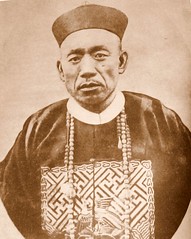 His life was a classic rags-to-riches story: Born of a poor family in T’ung-an hsien, he migrated to the Philippines in 1844. Although starting out in a measly position in the textile business, through hard work, tenacity, and acquired connections, he prospered.
His life was a classic rags-to-riches story: Born of a poor family in T’ung-an hsien, he migrated to the Philippines in 1844. Although starting out in a measly position in the textile business, through hard work, tenacity, and acquired connections, he prospered.Only about twenty years after arriving in Manila, he had risen as a powerful leader in the Chinese community. His wealth stemmed from importing enterprises, which included sugar and rice. He was also involved in coolie brokerage. Besides the businesses that he presided over, there were many commercial ventures in which his investments raked in enormous profits.
When he converted to Catholicism, his baptismal sponsor was Colonel Carlos Palanca Y Gutierrez — a Spanish forces leader in the Franco-Spanish intervention of 1858-62 in Cohin, China. He then assumed the name of his godfather (padrino); changing it from Tan Quien-sien to Carlos Palanca Tan Quien-sien. He eventually became widely known as Don Carlos Palanca.
He attained the position of gobernadorcillo from 1875-77, and again some years later; serving as the interim gobernadorcillo in 1885 and 1889. And when not in office, he continued to move behind the scenes with undisputed power; an effective arbitrator of disputes as well. For his services as gobernadorcillo, Spain granted him the Medal of Civil Merit and the Grand Cross of Isabel the Catholic.
He was always active in community affairs and philanthropy; raising funds for the community hospital and even provided a building for it himself in 1891. His generous donations extended outside of the Chinese community. There were many exemplary accomplishments attached to his name — the abolishment of vice in the community, the end of police extortions of the Chinese; the abolition of the death penalty for crimes committed by Chinese; and through powerful connections in Spain, softened Spanish legislation on the Chinese
He played a major role in the community’s efforts to obtain a Chinese consulate in Manila during the 1880s and 1890s. When the Americans took control of the country in 1898, he provided the American troops with temporary lodging arrangements, as well as furnished them with coolies to build their barracks. Subsequently, he urged the Ch’ing government to negotiate with the United States for a Chinese consulate in Manila. When the consulate was established in 1899, the Ch’ing government appointed his son, Ignacio Palanca Tan Chueco, to the position of first consul.
When the Philippine Revolution broke out he chose to keep distance; not committing to either side. When the Spanish government charged a number of mestizos with conspiracy, he argued in behalf of some of them and helped secure their release, though his attitude toward the Chinese mestizos was one of contempt. Not a believer of inter-racial marriage, he sent his son to a school in China to thwart his filipinization.
The Spanish and Filipinos, on the other hand, regarded Don Carlos Palanca with mixed sentiments. Their pervasive perception of him was that of a master corrupter; one who would resort to extreme measures just to get what he wanted.
He was thought of as a man obsessed with becoming the Chinese consul. He did assume the interim role of which when his son’s return from China was delayed for several months; unable to immediately fulfill his appointment as consul.
There were speculations among the Filipino intellectuals that Jose Rizal modeled after Don Carlos Palanca his character of Chinaman Quiroga in El Filibusterismo. Jose Alejandrino, a friend of Rizal, confirmed that it was indeed the case. Alejandrino further claimed that Don Carlos Palanca approached Aguinaldo — when he was forming his revolutionary government — about the possibility of creating an opium monopoly.
Despite such controversies, he was, undoubtedly, a powerful force in the Chinese community during the late nineteenth century. When he died in 1901, a statue was erected in the Chinese cemetery as a tribute to his community service and philanthropy.
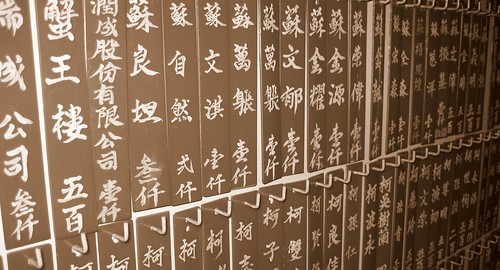
The Chinese in Philippine Life 1850-1898
By Edgar Wickberg
Ateneo de Manila University Press
Fei-lu-pin Min-li-la Chung-hua Shang-hui san-shi chou-nien k’an ed. Huang Hsiao-ts’ang
(Manila, 1936)
Labels: Binondo, Early Chinese, Manila history
posted by Señor Enrique at 6:45 AM
| 46 comments
![]()
![]()

Monday, September 25, 2006
ON CARLOS PALANCA STREET

This is Carlos Palanca Street heading towards Quezon Boulevard in Quiapo. The yellow building on the right is the Universidad de Manila (City College of Manila) where the old Clover Theater used to stand and where German Moreno started out as a janitor; behind it is FEATI.
Originally named Echague Street, this strip is quite famous for its affordably-priced housewares.

In addition, there are two longtime stores on this street that are quite popular as well. One is the Kim Chong Tin Hopia Factory; maker of the traditional hopia with thicker and toasted dough as opposed to Polland’s and Eng Bee Tin’s which is thinner and softer. Kim Chong Tin’s mini hopia is its best seller; the hopia mongo’s bag of eight pieces sells for P33.00.
The selling floor may appear spartan, but what most people do not know is that the bulk of this hopia factory’s income comes from the sale of its hopia filling, sold to bakeries nationwide.

Another product this street is famous for is cooked ham. This was where my father bought sliced ham and some freshly-baked rolls to be taken inside a movie theater for the entire family to feast on while watching a movie feature on a Sunday afternoon.

Excelente Cooked Ham is one of two stores on this street usually mobbed during the holidays. One kilo of sweet ham retails at P680.00, but one can buy as small as a quarter of a kilo for P170.00. Besides cooked ham, Excelente also offers other processed meat such as bacon and variants of it.

So the next time you plan on shopping for some cooking and baking wares, explore Carlos Palanca Street. Afterwards, try the traditional mini hopia at Kim Chong Tin and some sliced cooked ham at Excelente. If a ham sandwich is what’s on your mind, the Vienna rolls from the nearby Vienna Bakery are recommended.
At the tip of Carlos Palanca Street (from Plaza Lacson) is the Quiapo Bridge. Many of our wonderful handicrafts are sold at the stalls underneath the foot of the bridge.

Labels: Featured food, Manila history, Quiapo, walking tour
posted by Señor Enrique at 10:40 AM
| 30 comments
![]()
![]()

Sunday, September 24, 2006
MY ENGLISH READING LESSONS
 Passing by a newsstand can sometimes evoke a certain childhood memory — the time I made public yet another ambition; an added entry to my ever growing to-do list once grown up.
Passing by a newsstand can sometimes evoke a certain childhood memory — the time I made public yet another ambition; an added entry to my ever growing to-do list once grown up.It was early Saturday morning. My father was reading his paper as he usually did before going to the office. Leaning against the arm rest of his chair, told him that I wanted to become a radio announcer someday. As was often the case, my father silently pondered upon what I had just told him for a couple of minutes and then asked, “And what would you announce?” He probably assumed I was aspiring to join the genre that Kuya Eddie and Tiya Dely popularized during that period that glued my mother to her Sony transistor radio in the afternoons.
“The time and news update!” I exclaimed.
Upon hearing my response, my father slowly folded his paper and handed it to me. “Go ahead, read me the news.”
“But this is in English.” I objected.
“But it’s still the news?” he calmly retorted.
He has got to be kidding me! But when he reached for his pipe to fill it with some Prince Albert tobacco, I knew I’d better do some reading to show him I had what it took to someday actualize my dream. However, typical of early grade school pupils, I struggled quite pathetically with those English words printed in the Manila Times. Although I proceeded as if I knew what I was doing, I was actually oblivious to all those printed words; absolutely without any idea what they meant or how they were supposed to be pronounced.
Not once did my father interrupt to correct me; he just sat comfortably on his chair as he smoked his pipe. I’d often glance up from my reading to search his face for any sign of annoyance, but he seemed undisturbed by my tediously slow attempt, interspersed with “aaahh...” However, if asked, he would patiently show me how a word is pronounced and give its meaning.
And from that time on, whenever he saw me idly sitting by the window watching cars passed by, or without anything better to do, he would ask me to read him the news.
A couple of months later on, he brought home a copy of Reader’s Digest. He didn’t tell me to read it; just nonchalantly put it where the other magazines were. Its size — being smaller than the usual magazines of my older siblings — was supposed to connote it was intended for me. Yet, he wanted me to develop the interest to explore it on my own without his direct suggestion. I did.
When he saw me going through its pages, he started to bring home Reader’s Digest on a regular basis. I would ask my eldest brother (Junior, second to Fraulein) to read an article for me while my eyes focused on every word as he read it. He would stop every now and then to translate a certain passage in Tagalog so I would get the gist of it. Fraulein was not one to waste an opportunity. As she teased her hair to a bouffant and depleted the ozone layer with excessive application of hair spray, she’d make me read some articles and horoscope predictions from her magazines. She could be harshly critical of my English sometimes so I’d feign sudden illness (death if I could) just to avoid reading to her. I rejoiced when she left for the States — not because I wanted to get rid of her, but now she could make good on her promise to buy me a Lionel train set.
And so from then on, whenever my father took me to the movies, I started paying more attention to the English dialogue -- no longer on just the swashbuckling scenes as before. I would even try to visualize some spoken words. Later on, coming across those words in the newspaper or magazine, I would pronounce them the way I had heard them spoken in the movies. Consequently, I developed the habit of reading aloud every banner and billboard I saw along Manila’s streets or along the highway on our way to the province.
Now, the tough part:
Being the youngest, I was delegated to hang the mosquito net over my parent’s bed. But before doing so, I would sit on the bed and chat with my father while my mother was busily making sure everything was in order before going to bed. It was during those times that my father would ask me to recount the scenes he had missed from the movie we saw. I should mention that whenever my father took me to the cinema on those Saturdays after lunch, for the most part, he didn’t watch it along with me; he took a nap instead. I would just nudge him whenever he started snoring.
So now, besides reading him the news from the Manila Times, I would have to narrate the scenes he missed from those movies we went to see. And if I objected, he would say he’d never again take me to the movies on Saturdays — just with the entire family on some Sundays. So there I was, a young boy pitifully telling a story in English.
By the time I reached the fifth grade, I became quite comfortable with English — reading the news to my father with more confidence while my storytelling became bearably coherent. I was also tasked with the duty to read to the visiting relatives the letters and postcards from Fraulein and Napoleon (the third child next to Junior who enlisted in the U.S. Navy) about their sightseeing adventures.
Reading the news to my father continued until high school whenever I had no school in the mornings, as well as the evenings of narrations of scenes from the movies my father and I saw together or those just with my high school friends or brothers. By this time, my narrations had become more animated and extended; replete with paraphrased dialogues, but alas — my father would oftentimes be fast asleep and snoring before I got to the end.
When my father’s health turned for the worse — becoming comatose during his final months — I continued reading him the news even though unsure if he was even listening. Nonetheless, I thought it was the least thing I could do for my father who never once discouraged me from dreaming those grandiose dreams.
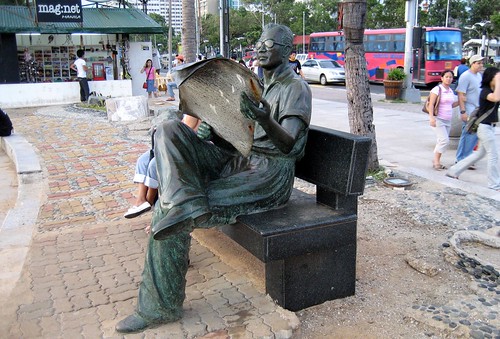
Labels: Growing up memoirs
posted by Señor Enrique at 7:17 AM
| 29 comments
![]()
![]()

Thursday, September 21, 2006
BANKING AND THE EARLY CHINESE TRADERS

This landmark building (now owned by the GE Money Bank) located on the corner of Plaza de Santa Cruz and Ongpin Street was once home to the oldest savings bank in the Philippines, Monte de Piedad and Savings Bank. It was founded by Fr. Felix Huertas (de Huerta) of the Franciscan Order with the funds of the Obras Pias.
Inaugurated on August 2, 1882, it was originally located at the ground floor of Santa Isabel College, corner of Arzobispo and Anda Streets in Intramuros. In 1894, it was transferred to the Roman Santos Building at Plaza Goiti where President Manuel L. Quezon was at one time employed as clerk. It was then moved to this landmark building in 1938, but the building was destroyed during the Battle of Manila in 1945. It was rebuilt in 1946 and resumed operation in 1947. It was administered by Archbishop of Manila until 1949 when it was incorporated.
Before the 1800s, without any banks in the Philippine archipelago, anyone with a sizeable venture that needed funding would have to obtain a loan from the obras pias.
The obras pias were pious foundations in which two-thirds of their holdings were allocated for the furtherance of commercial maritime ventures at interest — a voyage to Mexico was 50 percent, to China 25, and to India 35 — substantially increasing the foundation’s original coffer. Earnings from such interest rates were then assigned to other pious and benevolent purposes. A third was generally kept as a reserve fund to cover possible losses. Among the biggest obras pias was the Hermanidad de la Miscericordia, established in the late 16th century.
The opening of the Suez Canal largely contributed to a global economic growth during the decades from 1820 to 1870, and thereby producing similar significant changes in the economy of the Philippines as well. With the Spanish government granting shipping subsidies, local commodities such as sugar, fibers, coffee, and many others were briskly exported. A dramatic spike in foreign trade in the Philippines emerged as a result of such bustling commerce.
The British and Americans dominated the foreign trade in Manila while the local Chinese traders acted as primary intermediaries between them and the domestic market.
But access to the funds of the obras pias was absolutely forbidden to the Chinese. Therefore, before 1850, there wasn’t much capital available for the Chinese communities who were, ironically, Manila’s astute merchants.
Nonetheless, a number of Chinese enterprises struggled to remain lucrative. One could borrow at six percent interest from the Chinese community chests or caja, but the funds were never large. Outside of the community, individual Spaniards were a source of venture capital to individual Chinese entrepreneurs during the middle and late eighteenth century. But everything was more of personal level, nothing organized and of larger scale. Although there were a few private banking efforts initiated in Manila during the second quarter of the nineteenth century, it is not known whether they opened their doors to the Chinese.
However, banking was a key function of American and European businessmen in Manila. Funds were entrusted with them by rich families, the Church, Manila entrepreneurs, and even by the native banks that have slowly sprung up. These funds were then loaned out in the form of crop advances. But advances were also made to the Chinese wholesalers to help them dispose of European imports and to buy up produce for export.
Soon thereafter, another source of funds became available to the Chinese. In 1851, the Banco Espanol Filipino de Isabel II (later renamed BPI - Bank of Philippine Islands) was founded to promote the use of savings for commercial investments. Most of the funds from obras pias were transferred to it and the government added other funds of its own, turning it into a government-regulated, quasi-official institution. Although the bank’s first transaction was the discounting of a promissory note for a Chinese, regular transactions with Chinese merchants were facilitated by non-Chinese guarantors for a fee.
When Banco Espanol Filipino de Isabel II would ask the European merchant firms for the names of Chinese businessmen who were good risks, sensing opportunity, they did not provide the names of the Chinese jobbers and purchasing agents they did business with. Instead, these European firms became guarantors for Chinese borrowers from the bank, including forwarding their payments to the bank, and assuming responsibility for settlement with the bank in case the Chinese defaulted.
For the Chinese focused on wholesaling or retailing ventures, obtaining goods on credit was more important than access to cash loans. Hence, the European and American firms advanced their imported goods to the Chinese dealers while these dealers, in turn, made their profits without having to raise the capital to procure the products.
The Chinese in Philippine Life 1850-1898
By Edgar Wickberg
Ateneo de Manila University Press
.
Labels: Early Chinese, Manila history, Philippine history
posted by Señor Enrique at 11:04 AM
| 39 comments
![]()
![]()

Wednesday, September 20, 2006
THE EXCHANGE
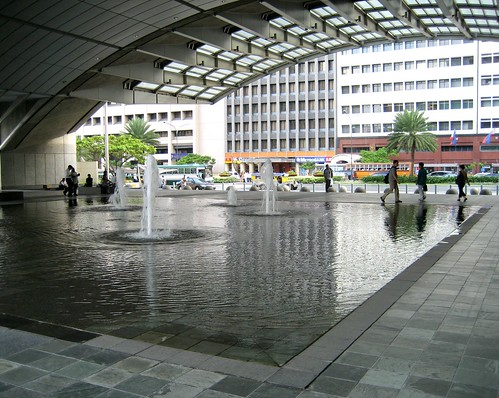
The incorporation of the Philippine Stock Exchange on July 14, 1992 was the culmination of exhustive efforts to integrate the Manila Stock Exchange and the Makati Stock Exchange as a unified entity. It has two sites: Tektite Tower at Ortigas Centre, Pasig City; and PSE Plaza, Ayala Triangle, Makati City — twin trading floors belonging to a single Exchange. The One Price-One Market exchange was achieved through the successful link-up of the two existing trading floors on March 24, 1994; hence PSE was established as the sole Exchange of the country.
 These photos were taken at the PSE Plaza, an ultra modern structure on Ayala Avenue with a beautifully landscaped park behind it.
These photos were taken at the PSE Plaza, an ultra modern structure on Ayala Avenue with a beautifully landscaped park behind it. Unfortunately, the Exchange will soon relocate to its new home in nearby Fort Bonifacio. The reason: Makati City has been a bad host for business.
Although hailed as the country’s financial center, it has also become the political rally capital of Metro Manila. Major rallies, unarguably, produce chaotic traffic jams, which in turn, precipitate lost man-hours and decelerated productivity; hence, bottom line figures awashed in red ink.
Notwithstanding, with or without these rallies, Makati City continually accumulates traffic build ups due to the glut of residential and commercial complexes confined in such a small area. In addition, Makati City's skyrocketing costs of property taxes, rentals and leases compel the bean counters to seek other viable, cost-effective locales.
Other businesses may soon follow PSE’s lead and join this exodus; reminiscent of when Makati’s Ayala took away from Escolta, Manila its title as the premier financial district of the Philippines. Now, Mandaluyong and Taguig have emerged as contenders for this prestigious distinction.
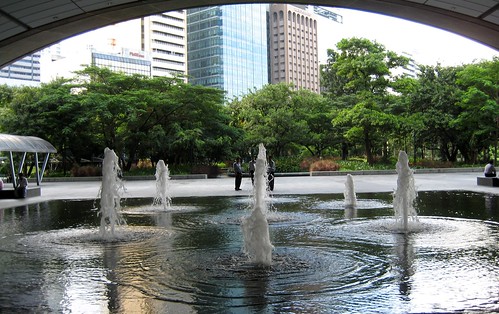
I very much appreciate my articles and photos appearing on fellow bloggers' sites, popular broadsheets, and local broadcast news segments, but I would appreciate even more a request for permission first.
Thank you!
*
posted by Señor Enrique at 8:23 PM
| 24 comments
![]()
![]()

Tuesday, September 19, 2006
HISTORY WEEK

Wrong values are being taught in history education. One is the overidealization of dying for the country. Though this may sound lofty, it is actually morbid and self-defeating. Jose Rizal speaking as Filosofo Tasio in Noli Me Tangere once wrote, “A dead hero is no use to his countrymen.”
His living countrymen may build monuments to him or deliver flattering speeches in his honor, but when asked to do the same, most likely would say, “What am I, stupid? Do not be a hero, because heroes are shot at the Luneta.”
Dying for the country might be ideal but living to fight for what is right and moral is preferable. History teachers must teach the students the value of struggle, not just for material things but also for the conviction of what is right and moral. The people who fight for these ideals are truly heroes, not necessarily the dead ones.
We can also pick lessons from another great man, US Army Gen. George S. Patton, who said to his men: “Don’t die for your country, let some other son of a bitch die for his!”
Read entire article:
Neglect and abuse of history: A sign of our waning patriotism
by Augusto V. de Viana
The Manila Times
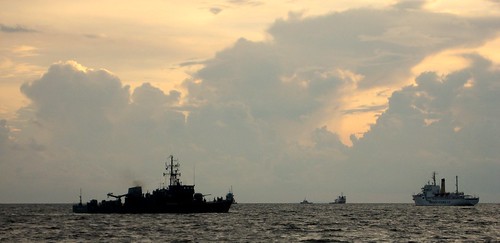
September 15 to 21 is History Week in the Philippine Archipelago
Source: MLQ3
posted by Señor Enrique at 8:00 PM
| 21 comments
![]()
![]()

SEVEN SONGS
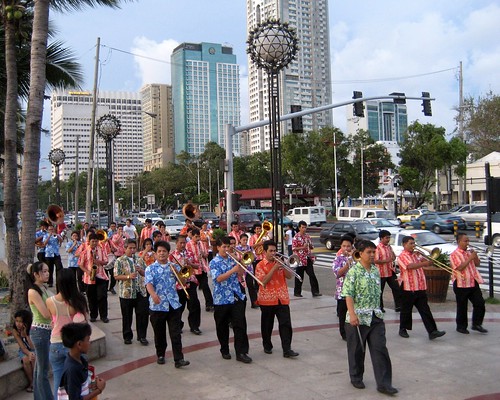
I was tagged by Bugsybee to name seven songs I prefer listening to these days.
They can be in any genre; with or without lyrics -- as long as they’re mellifluous.
So, here they are:
Masquerade by Leon Russell
Manha de Carnaval by Toots Thielemans
Remember the Future by Nektar
Bali Song by Rivermaya
Pachabel Canon by George Winston
Take it to the Limit by Etta James
Stay by David Bowie (with Earl Slick and Chris Spedding on guitars)
Now, I will tag seven other people to see what music they’re into these days:
Minotte
NeilDC
Cathy_bythesea
Kyels
Ferdz
Jase
Although I’m supposed to tag only seven blogmates, what I’ve done with the book meme I'll do here also -- invite everyone to join in if they feel like it. You’re welcome to put the list on my comment box if you don’t want to create a separate entry of it on your site.
Thanks and have fun!
posted by Señor Enrique at 6:31 PM
| 29 comments
![]()
![]()

Monday, September 18, 2006
MANILA'S PLAZA GOITI
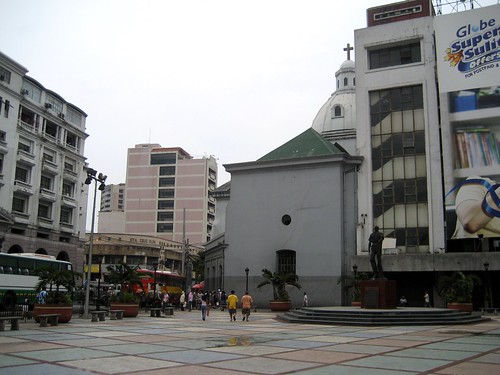
I was inspired to post this entry about Plaza de Goiti after seeing a very old photograph of it with horse-drawn carriages, as well as a postcard published in 1932 showing the area teeming with what look like Model T Fords. What a remarkable difference compared to the above photo.
It is now known as Plaza Lacson; a tribute for the soccer player at Ateneo de Manila University and amateur boxer who once challenged Ferdinand Marcos to a fistfight and called Ernesto Maceda (who was then a Manila councilor) “so young and so corrupt.” Arsenio Lacson was supposedly the best mayor the city of Manila ever had. His statue stands tall on a pedestal across the old Roman Santos Building.

To the left of Mayor Lacson’s statue is the LRT Carriedo Station. It was on Carriedo Street and Avenida Rizal where Henry Sy’s original ShoeMart once was. One block south of Carriedo is Carlos Palanca Street, named after Don Carlos Palanca whose real name was Tan Quien-sien; a wealthy and influential Chinese trader in Manila during the late 19th century. And right off MacArthur Bridge was the popular Clover Theatre; a vaudeville theater where Don Jose Zarah’s Extravaganza and jazz pianist Ping Joaquin (brother of writer Nick) entertained many of Manila’s inhabitants. The annex building of City College of Manila now stands on its spot.
The very first school, however, that established itself at Plaza Goiti was Adamson University, but it was originally called Adamson School of Industrial Chemistry. The Philippines’ steady progress towards industrialization during the early thirties demanded people to be trained in technology to man the increasing number of local industries. Inspired by this economic trend, three Greek cousins — Dr. George Lucas Adamson, Alexander Adamson and George Athos Adamson — founded the Adamson School of Industrial Chemistry on June 20, 1932. The School, which was set to train young men and women in Industrial Chemistry, was housed at the Paterno Building at Plaza Goiti. It opened on July 1, 1932 with only 42 students. A year later, the population grew to 300, which necessitated its transfer to more spacious quarters.
After the war, Dr. George Lucas Adamson re-opened the school, this time, in the premises of the Vincentian Fathers at San Marcelino Street. In 1964, the University was turned over to the Vincentian Fathers, which signaled the transformation of Adamson University to a Catholic Institution of learning.
Another learning enterprise that had its start at Plaza Goiti is the Far Eastern Aeronautics School, which in 1946 offered the first aeronautical classes in the country. It consequently received commendation from the Philippine Educational System for having pioneered in aeronautical education. In 1959 it became FEATI University with expanded academic programs, including architecture and fine arts. Among those who became dean of FEATI's School of Architecture was Juan Marcos de Guzman Arellano who designed the Post Office, Metropolitan Theater, and Legislative building. FEATI's five-storey building at Carlos Palanca Street behind the Plaza Fair building was completed in 1953.
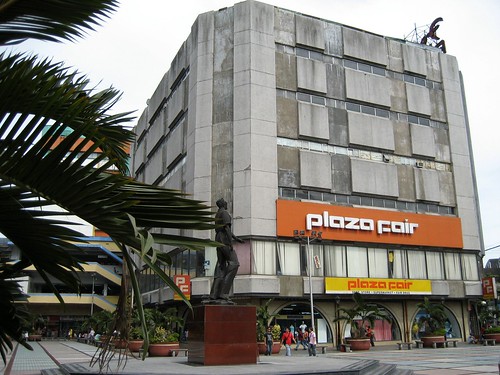
A major banking concern established on June 18, 1951 at Plaza Goiti was Security Bank and Trust Company. It has prospered even in the most trying times, remaining steadfast amidst the economic, political and social upheavals in the country’s history. It has steadily moved with the brisk pace of economic growth that characterized the 1950’s. Three years later, the corporate headquarters moved to Escolta, fittingly at the nation’s pre-eminent business district.
Another interesting, though somewhat morbid piece of trivia I dug up online: Citing its source as Turn of the Century by Gilda Cordeo Fernando and Nick Ricio, DLSU-D Website mentions La Funeraria, the first funeral parlor in the Philippines. It was supposedly established by Carlos March at no. 3 Plaza Goiti. It advertised hermetically-sealed coffins imported directly from Europe, embalming at moderate prices, “French Style Packing” of corpses, and an assortment of epitaphs. La Funeraria sternly warned the public against imitations and assured the public of guaranteed airtight coffins!
Its main competitor, the Phelipino Undertaking, a funeral parlor owned by Mr. Feliciano Quiogue, located at Calle Salazar, Trozo No. 2, offered luxurious funeral services consisting of one hearse with four horses, a metallic coffin and four attendants, with two carriages for mourners, all for P85.00!
The DLSU-D Website also mentioned a John Bancroft Devins who in 1905 wrote that the Spanish Friars collected varying fees for funeral services, depending on what robe they wore for the service and the length of prayers they offered. Every stroke of the church bell announcing the death would cost from tent cents to a dollar (P0.20 to P2). The Funeral itself could be ordinary, solemn or most solemn, with corresponding fees. Burial charges were extra. If the friar went all the way to the grave, it is twice as expensive if he went only half way. If death and funeral fees were not forthcoming, there can be no bells rung, no services held. Dying was expensive even for the poor who paid P30.00 for burial services!
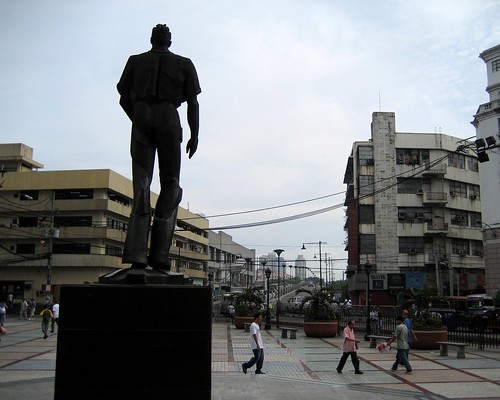
Martin de Goiti, for which this plaza was originally named after, was a Spanish conquistador and explorer who tricked the Muslim kings into believing that the Spaniards who came and camped in the shores of Manila Bay on May 8, 1570 were only visiting for a short period. As what usually happens with any overstaying visitors, the welcome mat would eventually get worn out and the host’s inhospitable thoughts would begin manifesting themselves. In short, the natives grew restless and started bickering with the visiting Spaniards.
Only sixteen days after their arrival, Goiti has had enough of these quarrels. He marched his 300 soldiers towards Tondo were they met thousands of native defenders, but somehow managed to defeat and kill most forces of Suliman, Lakandula and Matanda. Goiti took the rulers as prisoners; summarily torturing and executing those who refused to accept Spanish rule. Goiti and Juan de Salcedo, his second in command, then marched their armies towards the Pasig River and captured the city of Manila on June 6, 1570 and burnt it to the ground, killing more natives in the area.
After the battle, both sides were still unable to negotiate an agreement; hence, sporadic bloodsheds and sieges continued for another ten months. The Spaniards, on the other hand, fortified their outposts by erecting Fuerza de Santiago. Nonetheless, some battle-weary Spaniards would sometimes seek shelter aboard their fleets in Manila Bay.
Upon Legazi’s arrival in Manila on June 24, 1571, the Spaniards had finally taken control of the settlements and a peace agreement was put into effect. It was Goiti's bloody conquest that paved the way for the establishment of Manila as a permanent Spanish settlement and capital city of the Philippines. He later explored Pampanga, Pangasinan and founded several cities in Luzon from 1571 to 1573.
in the early periods of 1574, Goiti also fought against the invasion of 3,000 Chinese pirates and warriors who attacked Fuerza de Santiago, besieged certain parts of the city of Manila, and massacred most of the Spaniards in the city. Goiti was killed by the pirates’ leader, Lin Tao Kien, now known as Limahon or Li Ma Hong.
Spanish reinforcements came all the way from Vigan and Cebu. Juan de Salcedo left Ilocos Sur after learning of Goiti’s death and headed for Manila, which he later discovered as having fallen to the Chinese pirates. Salcedo's forces succeeded in driving out the Chinese pirates out of Manila. Li Ma Hong and his surviving soldiers retreated to Pangasinan, but were later captured. The death of Goiti was avenged by the Spaniards by burning Li Ma Hong and his warriors alive. Their warships were also burnt.
Martin de Goiti was laid to rest in a tomb inside the San Agustin Church in Intramuros.
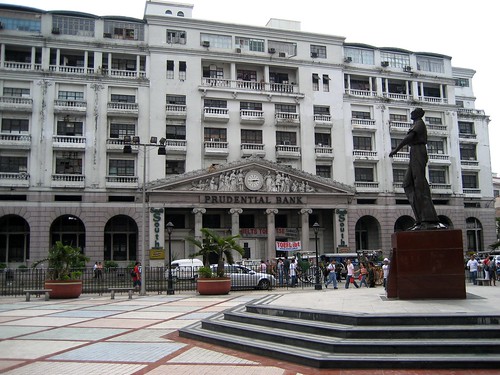
And finally, this Greco-Roman building — The Roman Santos Building — built by a successful businessman who also founded Prudential Bank.
Dona Marta Rodriguez y Tuason married Don Hilarion Santos. They had two children: Rafaela Santos y Rodriguez who married Vicente Fernandez and Roman Santos y Rodriguez who married Juliana Andres. After the death of Don Hilarion Santos, Dona Marta Rodriguez, viuda de Santos married Don Domingo Carlos.
Roman Santos y Rodriguez was raised as a ward by his first cousin Dona Florencia Sioco de Gonzalez in Barrio Sulipan, Apalit, Pampanga. Her elder sister, Dona Sabina Sioco de Escaler, lent him the initial capital to purchase his first bamboo "casco" (raft) with which he ferried the dry goods he was buying and selling in various towns.
Don Roman Santos y Rodriguez founded Prudential Bank. The building named after him still stands across from Plaza Goiti.
I very much appreciate my articles and photos appearing on fellow bloggers' sites, popular broadsheets, and local broadcast news segments, but I would appreciate even more a request for permission first.
Thank you!
*
Labels: life, life in Manila, Manila history
posted by Señor Enrique at 2:54 PM
| 35 comments
![]()
![]()

Sunday, September 17, 2006
AVENIDA RIZAL
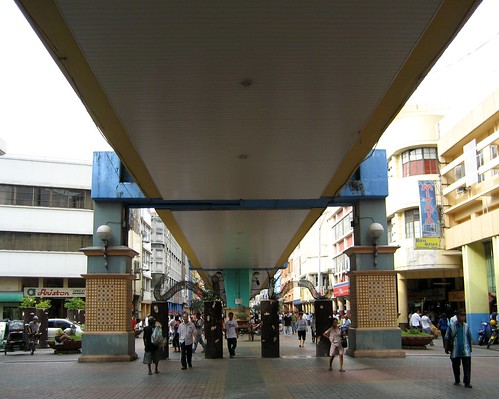
The proverbial "the road to hell is paved with good intentions" may have caused the eventual decline of this strip once agrind with bustling commerce.
Imelda Marcos’ original intention was to have a modern mass transit system — Light Rail Transit — to alleviate the gridlocks that paralyzed Manila’s main arteries, especially Rizal Avenue. Cursed with excessive delays, the project lingered for many years; leaving Rizal Avenue virtually impossible to traverse. Thus, many people were unable to continue patronizing the establishments on either side of it.
By the time the Light Rail Transit system was finished and began its regular operations, the fully air-conditioned SM shopping malls had sprouted throughout the metropolitan area and have earned the city shoppers' return visits. Regrettably, many of Rizal Avenue’s emporiums had lost too many of their regular customers; left with no other option but to shut their doors for good.
It took Mayor Lito Atienza’s tireless efforts to once again infuse life into to this area through a series of revitalization projects. From Carriedo Street to Claro M. Recto Avenue, Rizal Avenue has now become a colorful pedestrian’s haven.
Subsequently, more shops reopened to serve the public and all the facades of the buildings along the avenue were repainted. The ornamentations selected by the mayor to adorn the pillars that hold the overhead railway system were inspired by those he had seen during his visit to Spain.

The two new National Bookstore buildings flank Soler Street. I remember the time when I hurriedly finished off a hamburger and a cup of vanilla ice cream bought from a food shop next door to National Bookstore. General MacArthur had returned to Manila for a visit and his motorcade was supposed to pass by at any minute. I ate so fast that I felt nauseous afterwards. My father had to take me home immediately as soon as it was all over.
New Year’s Eve in the afternoon was the time of the year I enjoyed the most in this avenue. There were myriad vendors boisterously hawking various kinds of colorful noisemakers and firecrackers. Except for firecrackers which my mother had forbidden us to fool around with, my father and I would buy as many noisemakers as we could manage to carry for everyone in the household, as well as for cousins and friends in the neighborhood.
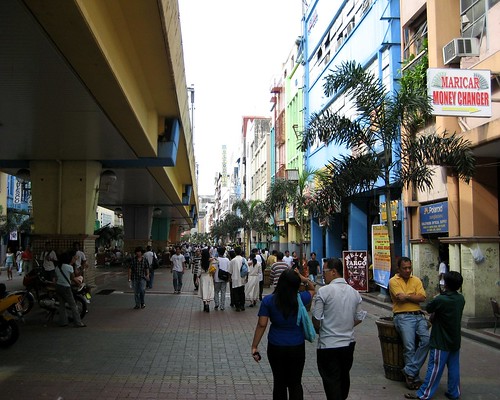
Sadly, the movie theaters along this avenue that brightened the night with their glorious neon lights — from Galaxy to Ideal — have ceased to exist. More recently, Avenue Theater, designed by National Artist for Architecture Juan Nakpil was torn down (read Carlos Celdran’s entry about the chance meeting he had with the owner of Avenue Theater who had it demolished).

I enjoyed many movies in Avenue Theater. A favorite, which got me riveted to my seat, was Wait Until Dark with Audrey Hepburn. She played the role of a blind housewife being terrorized by an intruder in her ground floor brownstone apartment.
Also, in this very same building, up in the banquet hall of Avenue Hotel was where my father’s business association held their annual soiree. He took me along on a couple of occasions. The most memorable was the night I sang some Beatle tunes accompanied by the band hired to provide the evening’s musical entertainment; a delightful experience, indeed.
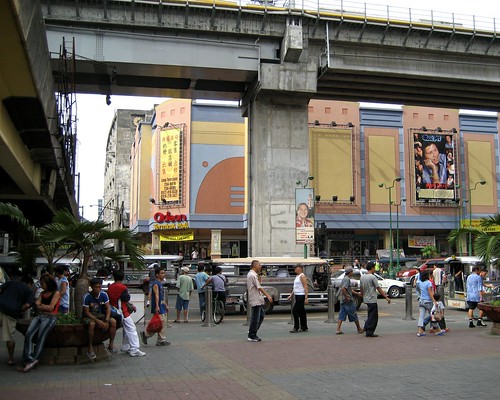
The old Odeon Theater was also demolished and replaced with a shopping mall, which was recently opened for business. It was in this theater I saw the Beatle’s Help, Steve McQueen’s The Great Escape, and Sean Connery’s Goldfinger.
The overhead rail system in front of the now Odeon shopping mall is the new MRT (Recto to Antipolo line) which has an interconnecting walkway with LRT that serves the Rizal Avenue route.
From this corner of Rizal Avenue and Recto (formerly Azcarraga), a couple of blocks to the left was where my father’s office was at Florentino Torres Street; whereas, a couple of blocks down the avenue is Doroteo Jose Street where MIT’s high school division was located. Ironically, when I started high school, not once did I walk over to my father’s office during recess or after school; I was already growing up and thought it uncool for my high school friends to take notice that I was still a papa’s boy. But nonetheless, I still went to the office with him on Saturdays.
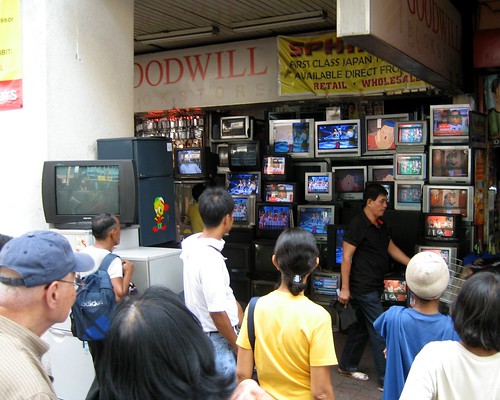
I very much appreciate my articles and photos appearing on fellow bloggers' sites, popular broadsheets, and local broadcast news segments, but I would appreciate even more a request for permission first.
Thank you!
*
Labels: life in Manila, Manila, Manila history, Rizal Avenue
posted by Señor Enrique at 9:57 AM
| 49 comments
![]()
![]()

Saturday, September 16, 2006
MY DAILY BREAD
 Abundant with affordably-priced cafes and restaurants, some friends in New York often equate my living in Manila with a daily indulgence in great meals that one would pay for handsomely like in Soho’s Filipino restaurant, Cendrillon.
Abundant with affordably-priced cafes and restaurants, some friends in New York often equate my living in Manila with a daily indulgence in great meals that one would pay for handsomely like in Soho’s Filipino restaurant, Cendrillon.There would be dead silence on the line whenever I’d mention my eating habits could be so bland at times that some well-heeled cousins had ascribed my sometimes austere gastronomical pleasure to some undisclosed life-threatening disease — followed by a whisper of, “Maybe that’s why he came back to Manila … to spend the end of his days.”
Truth be told, I sometimes wonder if my persona does tend to bring bad luck, for my favorite local eateries, which I could tirelessly go to on a daily basis, had disappeared — one is Juan Soy in Greenbelt, the other is Pinoy Don in Robinson’s Malate. I don’t even know if they have any branches anywhere else in the city.
Be that as it may, something I enjoy every morning is the pandesal. I call it the two-biter because its size nowadays only requires two bites to gobble up; average price is two pesos each at the neighborhood bakeries.
A couple of years ago, in my regular attempt to make sure my brain doesn’t go anywhere without my consent, I took a one-week baking class in Diliman, Quezon City. Now, here is what some bakers in my class told me (they were there for the certification required for overseas job applications): the texture of the morning pandesal differs from that of the afternoon which is more airy inside and toasted on the outside. How's that for trivia?

Chow King’s wanton noodle is another favorite of mine, which I would have for lunch whenever possible. It’s tasty and light — I don’t feel so bloated and lethargic afterwards. It costs about 68 pesos for the large bowl. It’s usually served very hot (the camera even caught the steam coming from it) so give it a few minutes before digging in.
I used to go to Ma Mon Luk in Quiapo for mami and siopao, but I noticed I felt sleepy afterwards. It wasn’t until another blogger had written about this restaurant that I found out about the true cause of this sleepiness — excessive MSG (monosodium glutamate). That was the end of that.
Now, some of you may be too young to remember Little Quiapo, but it was once very popular, especially among the students in the university belt area. Like Chow King, they were famous for their mami, siopao and halo-halo.
I very much appreciate my articles and photos appearing on fellow bloggers' sites, popular broadsheets, and local broadcast news segments, but I would appreciate even more a request for permission first.
Thank you!
*
Labels: Featured food, life in Manila, pandesal
posted by Señor Enrique at 11:17 AM
| 31 comments
![]()
![]()

Friday, September 15, 2006
MANILA BAY SUNSET - 9/15/06

I'd like to think that a beautiful sunset is God's way of saying "I love you and goodnight" to all His creatures, great and small.
But these pictures are my way of saying, "Have a wonderful and magical weekend everyone -- wherever you may be!"
Both pictures were taken this evening, September 15, 2006 at Baywalk, Roxas Boulevard, Manila.
I very much appreciate my articles and photos appearing on fellow bloggers' sites, popular broadsheets, and local broadcast news segments, but I would appreciate even more a request for permission first.
Thank you!
*
Labels: Manila Bay Sunset, photography
posted by Señor Enrique at 8:41 PM
| 15 comments
![]()
![]()

SOLO TRIP TO CHINATOWN

For the very first time in ages, I was able to gallivant on my own in Manila’s Chinatown and felt completely confident. Joining Ivan’s Big Binondo Food Wok tour certainly got me reacquainted with this area’s narrow streets, which I was once very familiar with as a kid.
Some of the things that piqued my interest as I enjoyed my solo flight walk were the foodstuffs being sold out in the streets such as the roasted chestnuts, which I used to enjoy especially during Christmastime in New York. I even had a friend who showed me how to roast them in a microwave oven.

There was also the tubo or sugar cane which brought back fond memories. As little kids, my friends and I would buy a long cane and have it cut into several pieces for us to share. They were always a sweet and refreshing treat, especially during the hot summer afternoons; however, it was rather challenging for the jaw. Also, you’d better have a good set of teeth to really enjoy them.

The atis was another delight – sweet and delicious, but a lot of work to eat because of its many seeds. This is my brother Taba’s favorite (he was the sixth sibling and aptly nicknamed Taba because he was chubby when young.) I remember him patiently peeling off the skin until there were only those at the bottom left. He would then slowly enjoy eating it, with ecstasy etched on his face. I would get more of a kick by watching him eat one instead of having one for myself.

These red things look fierce. They’re called dragon fruit. Never had one of these intriguing fruits before, but told they’re good. Considering they’re found more in Chinatown than in any other Manila neighborhoods, I’m afraid that if I had one I’d be off hallucinating for days and finding nirvana. However, the vendor assured me this fruit, though red, is not of the Papaver somniferum kind.

In the end, I settled for one of these — tikoy!
I'll be back in Chinatown more often with or without anyone in tow. Now that I know my way around, I will be enjoying this neighborhood as I used to when I was a kid.
I very much appreciate my articles and photos appearing on fellow bloggers' sites, popular broadsheets, and local broadcast news segments, but I would appreciate even more a request for permission first.
Thank you!
*
Labels: Binondo, Featured food, life in Manila, Manila Chinatown
posted by Señor Enrique at 8:13 AM
| 32 comments
![]()
![]()

Thursday, September 14, 2006
BIRTH OF JAZZ IN THE PHILIPPINES

that painting can never do, or sculpture. Music is capable of
going directly to the source of the mystery. It doesn't have
to explain it. It can simply celebrate it." - Marsha Norman
On August of 1898, as a measure to suppress the brewing discontent of the Filipinos, the U.S. Secretary of War, Elibu Root, ordered the transfer of American military troops to the Philippine archipelago. Part of this contingent who arrived in Manila were four Negroes — David Fagan, Lester Strongman, Paul Broduck and Waller Colts. Subsequently, having had enough of the racial insults constantly thrown at them by their fellow soldiers who were white, they deserted their ranks and sought refuge at Aguinaldo’s camp. These colored soldiers were then made members of the Filipino revolutionary forces as conscripts.
And during times of leisure, they introduced their Filipino counterparts to their own kind of music — blues and gospel — though still taking shape in the States at that time. These early American contemporary music became the backbone to what would eventually transpire as jazz.
This historical piece was part of Artemio Agnes’ story as featured in the book, Pinoy Jazz Traditions by Richie Quirino. I came across it when searching for listings of foreign musicians who performed in the Philippines after WWII; trying to figure out what concert performances my parents might have gone to during that time. My mother is not one to remember every name of foreign musician she saw with my father at Manila Hotel, Manila Opera House, or other clubs in the city from that period up to the sixties so I have to do some digging on my own.
Also mentioned in this book was the development of a particular style of jazz that was becoming popular in America in the early ‘40s, which found its way to Manila during the liberation. It was called bebop.
Supposedly, "bebop is a word which mirrored, onomatopoetically, the vocalization of the then best-loved interval of the music: the flatted fifth. The term ‘bebop’ came into being spontaneously when someone attempted to sing these melodic leaps.” In the next ten years, the flatted fifth had become a blue note, as common as the open thirds and sevenths familiar to the blues.
But Richie Quirino claimed “the characteristic sound of bebop seemed to be racing and full of nervous phrasing, frenzied and angry. Everything that was obvious was excluded. Most if not all the bebop jazz musicians of that era were addicted to alcohol and drugs. This was a way of deadening their senses and shutting out the realities of a world involved in struggles over power and dominance. As musicians are lovers of peace, bebop was an expression of their frustration and inner turmoil.” And there were many Filipino musicians eagerly learning and adopting this new kind of music into their respective jazz repertoire.
The liberation, among other things, brought with it a euphoric sense of festive mood, which made jazz synonymous with a celebration of victory. With thousands of entertainment-hungry GI’s roaming Manila, the local big bands found themselves heavily in demand.
But even before the liberation period, Filipino bands were playing jazz not only locally, but in Shanghai, Hong Kong, Singapore and Tokyo, as well as in oceangoing vessels plying the Pacific route. Notably, the '20s were known as the Jazz Age, the '30s and '40s were the Swing era. And just as band leaders Count Basie, Xavier Cougat, Duke Ellington and Benny Goodman were stars in America, Pinoy jazz had its own stars like Pete Aristorenas, Tirso Cruz, the Mesio Regalado Orchestra, the Shanghai Swing Masters and the Mabuhay Band.
My mother’s sister’s husband, Simeon de Luna, played clarinet for Tirso Cruz. Unfortunately, he wasn’t a big enough name to make it on Richie Quirino’s book, Pinoy Jazz Tradition, which also contains 100 rare photographs, poems and artworks; a must read for jazz lovers. It is available at all popular bookstores.
I very much appreciate my articles and photos appearing on fellow bloggers' sites, popular broadsheets, and local broadcast news segments, but I would appreciate even more a request for permission first.
Thank you!
*
Labels: jazz, music, Philippine history
posted by Señor Enrique at 6:14 AM
| 24 comments
![]()
![]()

Wednesday, September 13, 2006
THE PHILIPPINE PHILHARMONIC ORCHESTRA

It was after seeing the Lincoln Center in New York City that Imelda Marcos had the vision for a similar cultural and arts center to be built in Manila, which was soon erected on reclaimed land in Manila Bay and designed by famed Filipino architect, Leandro Locsin.
The Tanghalang Pambansa, more commonly known as the CCP Main Building, houses four theaters — a museum of ethnographic exhibits and a changing exhibit of Philippine art or ethnography, galleries, and a library on Philippine art and culture. It also houses the administrative offices and facilities of the CCP. Security personnel at the main building strictly enforce a no picture taking rule; therefore, I’m unable to provide a photo exhibit of the incredible interior of this venue.
There are so many performances going on here, but the one which attracts me the most is by The Philippine Philharmonic Orchestra; formally inaugurated on May 15, 1973 as the CCP Philharmonic Orchestra, initially intended to assist artists performing at the CCP Theater. In 1979, Imelda Marcos commissioned Prof. Oscar C. Yatco to reorganize it.
Three years later, the Philippine Philharmonic Orchestra was reborn as a world-class orchestra ranked among the best in the world. Under Music Director Eugene Castillo and Resident Conductor Cecinio Ronquillo, the PPO has consistently kept a busy concert schedule each year.
Its next performance at CCP will be “Noble Visions,” on October 13th, Friday at 8:00 pm. It features Najib Ismail on piano; Eugene Castillo will be conducting. However, the music they intend to perform has not been announced, yet. Tickets are from P350 to P900, which are incredibly cheap for a world class philharmonic orchestra performance.
Now, I am not nor have ever been an aficionado of classical music in a strict sense, but have always enjoyed listening to it whenever possible. What my friends and I often did in New York when young was buy the cheapest tickets at Lincoln Center or Carnegie Hall just to enjoy an afternoon or evening of orchestral music, which is, unarguably, great for the soul. Going to these classical concerts were in conjunction with the almost weekly rock concerts we used to attend at Howard Stern's Palladium in downtown Manhattan. I should also mention that my appreciation for orchestral music began when I watched those Warner Bros. cartoons on TV every afternoon when I was a kid.
Incidentally, there are about six art galleries within the main CCP building. One may go there early and view the current exhibits and installations, and then later on enjoy the philharmonic performance. For inquiries call the Museum and Visual Arts Division at 832-1125 local 1504/1505.
The telephone number for the Philippine Philharmonic Orchestra is 832-1125 local 1608-1610.

I very much appreciate my articles and photos appearing on fellow bloggers' sites, popular broadsheets, and local broadcast news segments, but I would appreciate even more a request for permission first.
Thank you!
*
Labels: CCP Complex, life in Manila, Local culture, music
posted by Señor Enrique at 6:39 AM
| 18 comments
![]()
![]()

Tuesday, September 12, 2006
ORCHIDARIUM at RIZAL PARK

It was once a parking lot until developed into a one-hectare rainforest-like park. Named The Orchidarium, it is a repository for orchids, as well as a variety of blooms, scents and greens; a project of the Clean & Green Foundation, Inc., headed by its president and chairperson, the former First Lady Amelita M. Ramos.
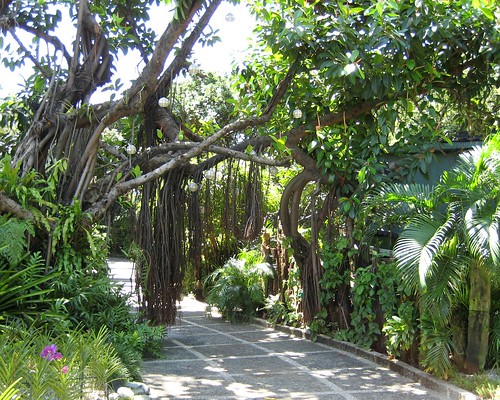
This park features a walkway that passes under the Trellis of Waves, a corner where clinging vines hang. Along this trail are different varieties of flowers and ornamental plants such as the Song blooms (Song of Thailand, Song of Korea, Song of Jamaica, and Song of India) and the Palm species (Anahaw, Fishtail Palm, Blue Palm, Pinanga, Majestic Palm and the McArthur Palm).
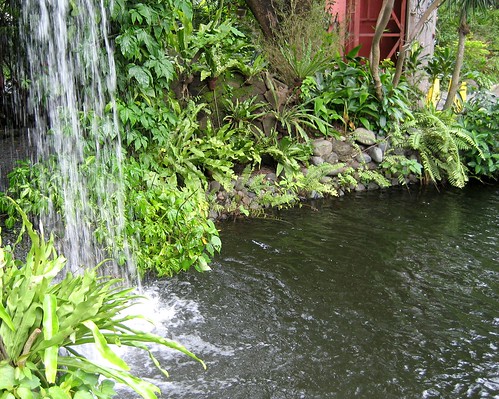
For those seeking a soothing respite from the hustle and bustle of Metro Manila, there is the Reflection Point where one could meditate with the surrounding exotic greens and refreshing waterfalls.
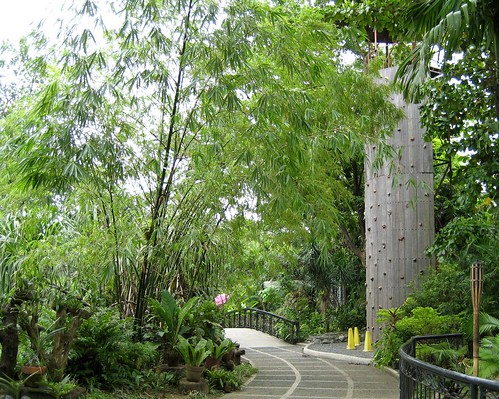
For the children and young adults, there is the Rocky Trail, which has a facility for sport wall-climbing. They can also go fishing at the Mystic Lagoon where bamboo poles can be rented.
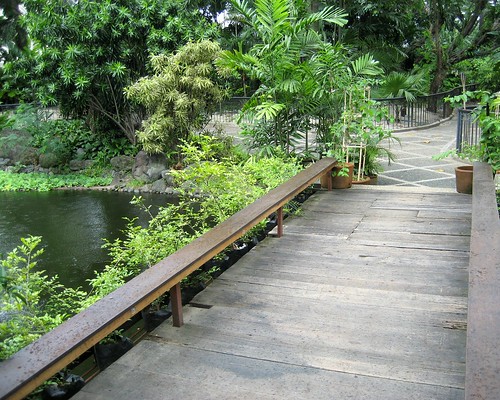
The Orchidarium was the beneficiary of a three-year initiative by mobile phone leader Nokia to enhance the park. The "Nokia Nurtured Zone" is dedicated to preserving the park's various flora and fauna, and is a venue for educational activities for young kids. There is also the Butterfly Pavilion sponsored by Nokia. A program called "Mondays with Nokia" is regularly held to teach schoolchildren the value of preserving the environment and one of its most precious resources: water.
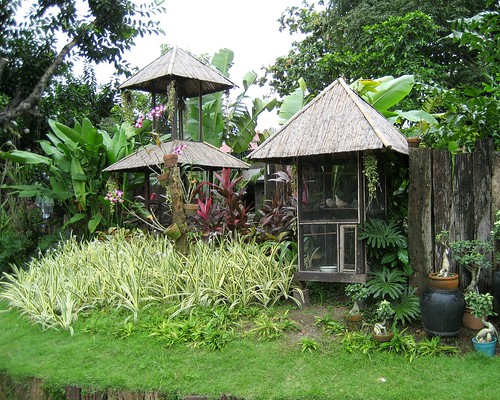
The park also offers Reflexology Walk — a pathway of healing stones that is part of the Nokia Nurtured Zone. Visitors are suggested to walk barefoot and enjoy soothing properties of the reflexology walk.
There is also a restaurant right at the center of the complex, for those who may want to enjoy a meal amidst the beauty of Nature. The current Lush Life and Garden Bistro will be taken over by Barbara's Restaurant this coming October. Barbara's main restaurant is located right near San Agustin Church over in Intramuros.
They also used to present live jazz performances here at The Orchidarium; there are no plans to bring back this music feature at this time.
The Orchidarium is located at the corner of Orosa Street and Finance Drive in Rizal Park (or Luneta); telephone numbers are 527-6376/6378 for further information.
I very much appreciate my articles and photos appearing on fellow bloggers' sites, popular broadsheets, and local broadcast news segments, but I would appreciate even more a request for permission first.
Thank you!
*
Labels: Manila, Orchidarium
posted by Señor Enrique at 7:37 AM
| 42 comments
![]()
![]()

Monday, September 11, 2006
IGNITING A GLOBAL MADNESS
 It was a gathering of New Yorkers to grieve the missing and the dead.
It was a gathering of New Yorkers to grieve the missing and the dead. More than 60,000 tickets were handed out to the families of firefighters, cops, rescue workers, and thousands of civilians who died in the World Trade Center collapse.
Oprah Winfrey and James Earl Jones hosted the event in which Placido Domingo soothed the crowd with his rendition of “Ave Maria” while Bette Midler exulted those who perished by singing “Wind Beneath My Wings.” Readings were given by religious leaders of various faiths.
There were gifts, too, for those who came to attend this event — tiny U.S. flags, fresh roses of assorted colors, and lots of stuffed toys for the children. My brother got me this crying bear (pictured above) when he attended this event at Yankee Stadium in the Bronx — “A Prayer for America” — on September 23, 2001, two days after his birthday
My brother who managed the pathology department of a downtown hospital in Manhattan was deeply affected by this incident. From the morning of the attack until several days later, he helped received many people holding pictures of their loved ones who worked at the World Trade Center. They were desperately searching for their missing loved ones by walking to every hospital in the city.
It was the most disheartening ordeal on a massive scale that my brother had ever experienced.
Ironically, I was not in New York City when it happened; I was in the Philippines on vacation for the very first time since leaving it many years ago. Together with some cousins, we were about to enter a music club in Tomas Morato when I received a call from a colleague in New York. He said the city was under attack.
Instead of going inside the club, my cousin suggested that we all go back to his house to check out CNN; we did. And there it was — the first tower collapsing only a few minutes after we arrived in his house. I couldn’t sleep well during the ensuing nights.
With pressing matters that needed attending to, it wasn’t until early November when I finally took a flight back home to New York. To make things worse, my dog of 17 years died of old age in mid-October while I was still in Manila. It was my poor brother who had to make all the necessary arrangements for his cremation. Nonetheless, he handed me the crying bear because he knew losing a beloved pet dog was much like losing a child.
My port of entry was Detroit International Airport. Immediately upon disembarking the plane and walking through customs, I noticed the remarkable change — National Guard personnel equipped with their menacing automatic weapons were all over the terminal. This reminded me of how my Jewish friend described Tel Aviv airport — spilling over with heavily-armed Israeli army soldiers.
There was an eerie silence aboard the Detroit to New York plane I was on as it approached the Manhattan skyline. The iconic twin towers were no longer there.
And during the following days after my return, the change of overall demeanor amongst New Yorkers became even more apparent — everyone seemed so much nicer to one another; a drastic change in attitude, which could have been brought about by being humbled by this tragic terrorist attack.
And on New Year’s Eve, along with a group of friends, I did what I had only done once before in my life — join the throngs of revelers at Times Square. It was a show of solidarity amongst fellow New Yorkers — a way to demonstrate our not succumbing to fear. Everyone refused to make the terrorists feel victorious.
Although in reality, the terrorists did manage somehow to change certain aspects of our lives for the worse — not only in America, but throughout the globe.
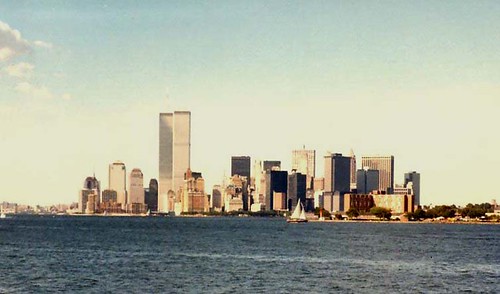
A picture I took of the Manhattan skyline during the mid-1980s.
I very much appreciate my articles and photos appearing on fellow bloggers' sites, popular broadsheets, and local broadcast news segments, but I would appreciate even more a request for permission first.
Thank you!
*
Labels: 9/11, Life in New York
posted by Señor Enrique at 10:54 AM
| 17 comments
![]()
![]()




